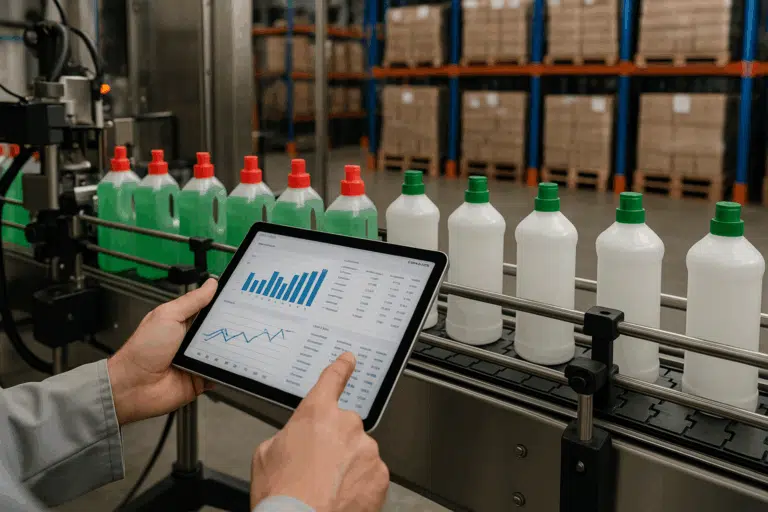At Grupo CPCON, with over 25 years of experience and a pioneering role in inventory technologies in Brazil, we recognize the crucial importance of efficient tool tracking in MRO (Maintenance, Repair, and Operations). Implementing RFID (Radio-Frequency Identification) has revolutionized how we manage tools and equipment, significantly enhancing the efficiency and safety of operations. This article explores how automated tool tracking with RFID can transform MRO, optimizing both time and costs associated with maintenance and repair.
Table of Contents
ToggleKey Takeaways
- RFID technology significantly enhances tool tracking efficiency in MRO, reducing tool loss and downtime.
- Integrating RFID with ERP systems streamlines inventory management and improves data accuracy and accessibility.
- Implementation of RFID can lead to substantial cost savings by minimizing the need for manual checks and reducing asset misplacement.
- Advanced RFID solutions support compliance with industry safety standards and regulations by ensuring tools are accounted for and properly maintained.
- Technological advancements in RFID are likely to further automate MRO processes, integrating seamlessly with emerging Industry 4.0 practices.
- Security and environmental considerations are vital, as RFID systems must protect data integrity and minimize ecological impact.
- Effective RFID deployment requires careful planning and collaboration across departments to ensure compatibility and maximize benefits.
- Exploring innovative applications of RFID in MRO can uncover unique benefits beyond conventional tool tracking, such as enhancing supplier and client relationships.
What is RFID Automated Tool Tracking in MRO?

RFID Automated Tool Tracking refers to the use of Radio-Frequency Identification technology to automate the tracking and management of tools in Maintenance, Repair, and Operations environments. Using RFID tags, readers, and integrated software, this system allows for stringent and real-time control of each tool within an MRO operation.
Fundamentals of RFID
RFID involves three main components:
- RFID Tags: Small electronic devices that can be attached to tools and other assets. Each tag contains a chip and an antenna, transmitting data to RFID readers.
- RFID Readers: Devices that pick up signals from RFID tags and relay the information to a processing system.
- Management Software: Where the collected data is analyzed and managed, facilitating an overall view of inventory, maintenance status, and tool history.
Implementation in MRO
Implementing RFID in MRO involves several steps:
- Tool Tagging: Each tool is given a unique RFID tag.
- Reader Setup: Readers are installed at strategic points for continuous data capture.
- Software Integration: The tool management software is configured to receive and process information from the readers, providing real-time reports and alerts.
Advantages of RFID in MRO
The use of RFID for tool tracking in MRO offers several advantages:
- Real-Time Visibility: Continuous monitoring of tool usage and location.
- Error Reduction: Minimizes losses and human errors in inventory control.
- Operational Efficiency: Speeds up processes and reduces machine downtime due to missing proper tools.
At Grupo CPCON, we have adopted this technology to ensure that each maintenance operation is carried out with maximum efficiency, safety, and cost control. Next, we will delve deeper into the benefits and challenges of implementing RFID tracking systems in MRO environments.
How RFID Automated Tool Tracking Works

Understanding how RFID technology functions within an MRO (Maintenance, Repair, and Operations) framework is key to leveraging its full potential for automated tool tracking. Below is an in-depth examination of the workflow and technology behind RFID tool tracking in an MRO setting.
Step-by-Step Process of RFID Tool Tracking
- Tagging Tools with RFID Tags: Each tool in the inventory is equipped with an RFID tag that stores a unique identifier. These tags are crucial for the system’s ability to track each tool’s location and usage history. Tags can be passive, which do not require a battery and are generally cheaper, or active, which include a battery for a larger range and more robust data transmission.
- Setting Up RFID Readers: Readers are strategically installed throughout the MRO facility to capture data from tags as tools move in and out of range. These can be fixed installations at strategic points such as entry/exit doors or portable devices handled by personnel.
- Data Transmission: When a tool equipped with an RFID tag passes near a reader, the reader detects the tag and captures data such as the tool’s ID, the time, and its current location. This automatic capture of information is quick and reduces the likelihood of human error.
- Integration with Management Software: The data collected from the readers is then transmitted to a centralized management software system. This system integrates the tool tracking data with other vital operational systems, such as inventory management and ERP software, facilitating a comprehensive view of asset utilization and availability.
Key Components of an RFID System in MRO
The RFID system in an MRO setting includes several key components:
- RFID Tags: These are small and robust enough to withstand the harsh environments of MRO activities. They must be durable to adhere to various types of tools and withstand regular use.
- Readers: These are sophisticated devices designed to read RFID tags accurately. They must be capable of reading data in environments that may be challenging, such as those with high metal content or other interference factors.
- Software: The backbone of the RFID system, this sophisticated software handles data analysis and reporting. It offers features like real-time tracking, inventory forecasts, maintenance scheduling, and regulatory compliance management.
How RFID Enhances MRO Operations
RFID technology brings numerous enhancements to MRO operations:
- Automated Check-In/Check-Out: Tools are automatically recorded as they are issued and returned, minimizing paperwork and the potential for manual entry errors. This automation speeds up operations and enhances productivity.
- Maintenance Alerts: The system can alert managers when tools require maintenance or calibration, which helps ensure that all tools are in optimal working condition and available when needed.
- Loss Prevention: Immediate notifications can be triggered if a tool is taken beyond a designated area or not returned on time, which helps in quickly addressing potential losses or misuse.
Visualization and Reporting
Effective RFID systems offer robust visualization and reporting capabilities:
- Real-Time Monitoring: Operational dashboards provide live updates on where each tool is located, who is using it, and its status, which aids in immediate decision-making and increases operational responsiveness.
- Historical Data Analysis: By analyzing long-term data, MRO facilities can identify usage patterns, optimize inventory levels, and plan for future needs based on actual usage data.
- Customized Reports: The flexibility to generate customized reports allows different departments within the organization to receive information tailored to their specific needs, enhancing overall operational efficiency.
Through these mechanisms, RFID technology not only streamlines the management of tools and equipment in MRO settings but also provides a strategic advantage by offering detailed insights into asset utilization, maintenance needs, and operational efficiencies.
Benefits of RFID in MRO Tool Tracking

Implementing RFID technology in Maintenance, Repair, and Operations (MRO) settings has brought significant advancements in how tools and equipment are managed. At Grupo CPCON, we have seen firsthand how this technology can transform operational efficiencies, reduce costs, and enhance tool security.
Enhanced Operational Efficiency
RFID systems streamline several aspects of MRO management:
- Automated Tool Tracking: Tools are tracked automatically as they move throughout the facility, reducing the need for manual logging.
- Quick Tool Retrieval: Workers can locate and retrieve tools quickly, reducing downtime and increasing productivity.
- Accurate Inventory Management: Real-time updates ensure that inventory records are always current, minimizing the risks of overstocking or stockouts.
Efficiency Example:
“In our operations, RFID technology has reduced tool retrieval times by up to 70%, directly enhancing our workflow efficiency.”
Cost Reduction
Adopting RFID can significantly cut costs associated with tool management:
- Decreased Labor Costs: Automation reduces the manpower needed for inventory and tool tracking.
- Minimized Tool Losses: Enhanced tracking capabilities lead to fewer lost or misplaced tools, reducing replacement expenses.
- Lower Downtime Costs: Faster tool retrieval and accurate tool maintenance scheduling prevent costly delays in MRO activities.
Improved Tool and Equipment Security
Security is paramount in MRO operations, and RFID provides robust solutions:
- Theft Prevention: Tools are monitored in real-time, making unauthorized removals easy to detect.
- Access Control: Only authorized personnel can access certain tools, thanks to integrated RFID reader checkpoints.
- Audit Trails: Every tool transaction is logged, creating a transparent audit trail for compliance and security checks.
Table: Summary of RFID Benefits in MRO
| Benefit | Description | Impact |
|---|---|---|
| Operational Efficiency | Automated tracking and quick tool retrieval | Reduces time and effort in tool management |
| Cost Reduction | Minimizes labor and tool loss expenses | Lowers operational costs |
| Security Enhancement | Real-time monitoring and access control | Improves tool security and accountability |
Strategic Decision-Making Support
RFID data supports strategic decisions in MRO management:
- Predictive Maintenance: RFID systems enable predictive analytics for maintenance scheduling, which can help avoid unexpected equipment failures.
- Inventory Optimization: Data analysis helps in fine-tuning inventory levels based on actual usage patterns, ensuring optimal stock levels without overinvestment.
- Regulatory Compliance: Automated records support compliance with industry regulations, reducing the risk of penalties and enhancing operational standards.
Insight from Industry Data:
“According to industry studies, organizations using RFID for tool tracking report a 30% improvement in equipment uptime.”
By integrating RFID into our MRO operations, we, at Grupo CPCON, have not only streamlined our workflows but have also secured and optimized our tool management processes, paving the way for continued innovation and improvement in our services.
Challenges in Implementing RFID in MRO

While the benefits of RFID in MRO tool tracking are significant, implementing this technology also presents certain challenges. At Grupo CPCON, we have navigated these hurdles through careful planning and strategic implementation, ensuring our operations remain efficient and effective.
Technical and Environmental Challenges
The deployment of RFID systems in MRO settings involves complex technical and environmental considerations:
- Interference Issues: RFID technology can experience signal interference from metal surfaces and other electronic devices commonly found in MRO environments.
- Tag Placement: Finding optimal placements for RFID tags on various tools, especially those made of metal, which can impede RFID signals.
- Durability Concerns: RFID tags must be robust enough to withstand harsh working conditions without failing or becoming detached.
Technical Insight:
“RFID readers and tags must be specifically selected and tested to ensure compatibility with the unique environmental conditions of each MRO facility.”
Cost Implications
Implementing RFID technology involves significant upfront costs:
- High Initial Investment: Costs include purchasing RFID tags, readers, and integrating software systems.
- Ongoing Maintenance: RFID systems require regular maintenance and updates to ensure they continue to function optimally.
- Training Expenses: Staff must be trained not only on using the system but also on troubleshooting common issues.
Organizational and Cultural Challenges
Integrating new technologies into established workflows can meet resistance:
- Change Resistance: Some employees may resist changing from familiar manual tracking methods to a new, automated system.
- Integration with Existing Systems: Ensuring RFID systems work seamlessly with existing MRO management software can be complex and time-consuming.
Table: Key Challenges of RFID Implementation in MRO
| Challenge Category | Specific Issue | Potential Impact |
|---|---|---|
| Technical | Signal interference and tag placement | Can affect the accuracy of tool tracking |
| Cost | Initial investment and maintenance | Affects project budget and ROI |
| Organizational | Resistance to change and system integration | May delay adoption and reduce effectiveness |
Overcoming the Challenges
Despite these challenges, the advantages of RFID in MRO can be fully realized with the right approaches:
- Pilot Testing: Implementing a pilot project can help identify and address potential issues before a full-scale rollout.
- Vendor Support: Choosing the right technology partners who offer comprehensive support and training can ease the integration process.
- Continuous Improvement: Regularly reviewing and updating RFID applications as technology advances and operational needs change.
By facing these challenges head-on, we at Grupo CPCON have managed to integrate RFID technology into our operations successfully, continually enhancing our efficiency and service quality. This proactive approach ensures that we remain leaders in the MRO industry, always ready to adopt innovations that drive our success.
Case Studies: RFID Success in MRO
At Grupo CPCON, we believe that real-world examples illuminate the transformative impact of RFID technology. Here, we present two case studies that demonstrate the effectiveness of RFID in dramatically improving operational efficiency and asset management.
Case Study 1: Seattle Public Library
The Seattle Public Library in the United States faced a common challenge among large libraries: managing its vast inventory of books. With thousands of items circulating daily, manual tracking and inventory control were both cumbersome and error-prone.
Implementation of RFID
To address this issue, the library implemented an RFID system. Each book was equipped with an RFID tag, storing information about the book that could be read remotely by RFID scanners. This allowed the library to automate many of its inventory control tasks, such as:
- Book check-ins and check-outs
- Tracking of lost books
- Shelf management
Results
The outcomes were highly beneficial:
- Operational Efficiency: The library saw a significant improvement in operational efficiency.
- Error Reduction: There was a notable decrease in manual errors.
- Improved Inventory Control: Enhanced tracking and management of book inventories.
Insight from the Library’s Staff:
“RFID technology has freed up our staff to focus on more important tasks like customer service and event programming, transforming our library’s operations.”
Case Study 2: Ghent University Hospital
Ghent University Hospital in Belgium faced the challenge of tracking and managing its numerous valuable assets, including medical equipment, devices, and supplies. Manual tracking was time-consuming and prone to errors, leading to asset loss and operational inefficiencies.
Implementation of RFID
The hospital implemented an RFID system where each asset was equipped with an RFID tag, enabling:
- Real-time tracking of location and status of each item.
- Immediate updates on equipment availability and maintenance needs.
Results
The implementation led to substantial improvements:
- Operational Efficiency: Significant enhancement in operational procedures.
- Asset Loss Reduction: Marked decrease in the loss of valuable medical equipment.
- Improved Patient Care: Ensured that necessary equipment and supplies were always available when needed.
Feedback from Hospital Management:
“RFID technology has not only improved our asset management but also significantly boosted our patient care services by ensuring equipment availability.”
| Case Study | Sector | Key Improvements |
|---|---|---|
| Seattle Public Library | Public Sector | Efficiency, Error Reduction, Inventory Control |
| Ghent University Hospital | Healthcare | Operational Efficiency, Asset Management, Patient Care |
These case studies illustrate the power and efficacy of RFID technology in asset management across different sectors. Whether in a public library or a hospital, RFID has proven to be a valuable tool for enhancing operational efficiency and asset management.
Future Trends in RFID and Tool Management
As we at Grupo CPCON look towards the future, we anticipate several exciting advancements in RFID technology and tool management that will further enhance operational efficiencies and integration capabilities in industries globally.
Technological Advancements
- Enhanced Data Analytics: With improvements in RFID technology, the ability to gather and analyze data will become more refined, providing deeper insights into tool usage and lifecycle management.
- Integration with IoT: RFID is expected to become more integrated with the Internet of Things (IoT), allowing for more comprehensive monitoring systems that communicate seamlessly across platforms.
Insight from Technology Forecasts:
“Experts predict that by 2025, RFID will be fully integrated with IoT, leading to smarter workplaces where tools are virtually linked and constantly communicating their status.”
Increased Automation
- Automated Replenishment: Future RFID systems will likely include features for automatic tool replenishment, ensuring that stock levels are maintained without manual intervention.
- Predictive Maintenance: Enhanced RFID systems will facilitate predictive maintenance, automatically alerting when tools need servicing based on usage patterns and historical data.
AI and Generative AI Integration
- AI-Enhanced Decision Making: The integration of Artificial Intelligence with RFID systems is set to revolutionize how data is interpreted, enabling more complex decision-making processes and optimizing operations without human intervention.
- Generative AI Applications: Use of generative AI could reshape inventory management, where AI could predict and generate requisition orders automatically based on historical trends and predictive analytics.
Forward-Looking Statement:
The potential for AI to automate complex decision-making in tool management is immense, with generative AI poised to automate entire segments of supply chain logistics.
Environmental Sustainability
- Eco-Friendly Tags: There is a growing trend towards developing more environmentally friendly RFID tags, which are easier to recycle and have a reduced environmental impact.
| Trend | Description | Expected Impact |
|---|---|---|
| Data Analytics | Improved analysis capabilities for tool management | Greater precision in inventory and usage tracking |
| IoT Integration | Seamless communication between tools and systems | Enhanced operational efficiency |
| AI and Generative AI | AI-driven analytics and automation in tool management | Streamlining operations and reducing human error |
| Automated Systems | Development of systems for automated replenishment | Reduction in manual processes |
Integration of RFID with ERP Systems
Integrating RFID with Enterprise Resource Planning (ERP) systems is a crucial step towards optimizing asset management and operational efficiency in any organization. At Grupo CPCON, we have experienced firsthand the benefits of this integration.
Benefits of Integration
- Real-Time Inventory Updates: RFID integration with ERP systems provides real-time updates to inventory levels, significantly reducing discrepancies and improving order accuracy.
- Enhanced Visibility: This integration offers a holistic view of asset locations and statuses across the organization, aiding in strategic decision-making.
Implementation Challenges
- System Compatibility: Ensuring that the RFID system is compatible with the existing ERP software can pose challenges, requiring specialized integration efforts.
- Data Security: As with any system that handles extensive amounts of data, ensuring the security and integrity of the data transmitted between RFID systems and ERP is paramount.
Strategies for Successful Integration
- Pilot Programs: Testing the integration on a small scale initially can help identify potential issues before a full rollout.
- Vendor Collaboration: Working closely with RFID and ERP system providers ensures that the integration is tailored to the specific needs of the organization.
Professional Insight:
“Effective integration of RFID with ERP systems can lead to a 20% reduction in inventory holding costs and a 15% decrease in manual labor involved in inventory management.”
By embracing these future trends and continuing to integrate RFID technology with ERP systems, we at Grupo CPCON are positioning ourselves at the forefront of innovation, ensuring that we remain competitive and continue to deliver high-quality services to our clients.
RFID and Industry 4.0
As pioneers at Grupo CPCON, we recognize that RFID is a cornerstone technology in the revolution known as Industry 4.0. This integration significantly enhances digital connectivity and automation in manufacturing and supply chain processes.
Role of RFID in Industry 4.0
- Data Integration: RFID serves as a critical data source for Industry 4.0, providing real-time asset tracking and inventory data that feeds into larger automated systems.
- Enhanced Connectivity: RFID technology enables objects to communicate with IoT devices, creating a fully interconnected environment that enhances process automation.
Industry Insight:
“In the context of Industry 4.0, RFID is not just a tool for tracking; it’s a fundamental component that bridges the physical and digital worlds, enabling the creation of smart factories.”
Automation and Smart Factories
- Automated Processes: In smart factories, RFID tags monitor the movement and condition of goods automatically, facilitating a seamless flow of information.
- Predictive Analytics: With RFID-generated data, predictive models can forecast maintenance and optimize manufacturing processes, reducing downtime and increasing efficiency.
Table: Impact of RFID in Industry 4.0
| Feature | Function | Benefit |
|---|---|---|
| Real-Time Data | Provides immediate updates to the production line | Enhances decision-making and reduces errors |
| Connectivity | Links assets with systems and personnel | Increases operational efficiency and productivity |
| Automation | Supports automated reporting and decision-making | Streamlines operations and reduces manual labor |
Compliance and Security in RFID Implementations
Ensuring compliance and security in RFID implementations is crucial. At Grupo CPCON, we adhere to stringent standards to protect data integrity and align with regulatory requirements.
Compliance Requirements
- Data Protection Laws: We ensure that our RFID systems comply with global data protection regulations such as GDPR and CCPA by implementing robust data management practices.
- Industry Standards: Compliance with industry-specific standards and regulations is maintained to ensure that RFID implementations meet all legal and operational criteria.
Security Measures
- Encryption: RFID data transmissions are encrypted to prevent unauthorized access and ensure data security.
- Access Controls: Access to RFID data is strictly controlled, with permissions granted only to authorized personnel.
Mitigating Risks
- Regular Audits: Conducting regular security audits helps in identifying and mitigating potential vulnerabilities in RFID systems.
- Security Protocols: Implementing up-to-date security protocols ensures that the RFID infrastructure is protected against emerging threats.
Security Insight:
“Recent studies indicate that integrating advanced encryption within RFID systems can reduce security breaches by up to 60%.”
Table: Compliance and Security Protocols in RFID
| Protocol | Description | Impact |
|---|---|---|
| Encryption | Secures data transmission | Protects against data breaches |
| Audits | Regular examination of security practices | Ensures ongoing compliance and identifies risks |
| Access Control | Restricts data access to authorized personnel | Minimizes unauthorized data access |
By prioritizing compliance and security in our RFID implementations, we at Grupo CPCON not only safeguard our operations but also reinforce our commitment to maintaining the highest standards of data integrity and regulatory adherence.
RFID Tool Tracking and Environmental Impact
At Grupo CPCON, we are keenly aware of the environmental implications of deploying RFID technology in tool tracking. As sustainability becomes a core component of corporate responsibility, understanding and mitigating the environmental impact of RFID systems is paramount.
Environmental Concerns
- Electronic Waste: RFID tags contain electronic components that can contribute to e-waste if not disposed of properly.
- Resource Usage: The production of RFID tags involves materials such as plastics and metals, which require energy and resources to manufacture.
Environmental Insight:
“A study from the Environmental Research Institute noted that adopting eco-friendly materials in RFID tag production can reduce carbon footprints by up to 30%.”
Sustainability Initiatives
- Recyclable Materials: Development of RFID tags using biodegradable or recyclable materials to minimize environmental impact.
- Energy-Efficient Production: Implementing energy-efficient processes in the manufacture of RFID components to reduce the overall environmental footprint.
| Strategy | Description | Environmental Benefit |
|---|---|---|
| Eco-Friendly Tags | Use of biodegradable materials in tag production | Reduces waste and environmental impact |
| Energy Efficiency | Adoption of green manufacturing practices | Lowers energy consumption and emissions |
Innovative RFID Technologies in MRO
Innovation in RFID technology is continually evolving, pushing the boundaries of what’s possible in Maintenance, Repair, and Operations. At Grupo CPCON, we embrace these advancements to enhance our services and provide cutting-edge solutions to our clients.
Recent Innovations
- Advanced Analytics: New RFID tags with embedded sensors not only track tools but also gather data on usage patterns, temperature, and stress levels, providing deeper insights into tool condition and maintenance needs.
- Hybrid Tags: Development of tags that combine RFID with other technologies like Bluetooth or GPS, offering enhanced tracking capabilities over larger distances.
Technology Update:
“Recent advancements in RFID tag technology have led to the development of tags capable of operating in extreme conditions, enhancing reliability in harsh MRO environments.”
Benefits of Innovation
- Enhanced Tracking Accuracy: Hybrid technologies enable more precise tracking and location of tools within large or complex facilities.
- Improved Tool Maintenance: Sensor-embedded tags allow for real-time monitoring of tool conditions, facilitating proactive maintenance and extending tool life.
| Innovation | Function | Benefit |
|---|---|---|
| Sensor-Embedded Tags | Monitor tool usage and environmental conditions | Provides actionable insights for maintenance |
| Hybrid Tags | Combine RFID with Bluetooth or GPS | Expands tracking capabilities and accuracy |
By integrating these innovative RFID technologies into our MRO practices, we at Grupo CPCON are not only advancing our operational capabilities but also contributing to environmental sustainability and pushing the envelope of what is technologically feasible in our industry.
Vendor Insights: Leading RFID Solutions for MRO
At Grupo CPCON, we pride ourselves on providing a leading-edge RFID solution specifically designed for the needs of Maintenance, Repair, and Operations (MRO). Our comprehensive approach to RFID tool tracking encompasses state-of-the-art technology, seamless integration, and robust support, setting industry standards for effectiveness and reliability.
Overview of CPCON’s RFID MRO Solution
Our RFID solution integrates advanced tagging technology, reader equipment, and sophisticated software to ensure optimal performance in MRO environments:
- High-Quality RFID Tags: Designed to withstand the rigors of industrial environments, ensuring durability and reliability.
- Powerful Readers: Capable of capturing tag data accurately across various ranges and conditions.
- Intuitive Software: Provides easy-to-use interfaces and powerful data analytics for comprehensive tool tracking and inventory management.
Expert Endorsement:
“Grupo CPCON’s RFID solution has been recognized as the best overall for MRO applications due to its robustness and adaptability to complex industrial needs.” — Industry Technology Review
Key Features of Our Solution
- Scalability: Easily scales to meet the needs of any size operation, from small workshops to large manufacturing facilities.
- Real-Time Tracking: Offers real-time updates, reducing downtime and increasing productivity.
- Integration Capabilities: Seamlessly integrates with existing ERP systems, enhancing data consistency and operational flow.
| Feature | Benefit | Impact |
|---|---|---|
| Durability | Tags designed for harsh environments | Ensures long-term usability and reliability |
| Data Accuracy | High-performance readers | Minimizes errors and improves operational efficiency |
| Software Integration | Compatible with major ERP systems | Streamlines workflows and data management |
Client Testimonials
Our clients consistently report significant improvements in operational efficiency and asset management after implementing our RFID solution:
- Manufacturing Firm: “Since adopting CPCON’s RFID system, our tool tracking accuracy has improved by over 50%, dramatically reducing incidents of tool loss and misplacement.”
- Aerospace Industry Client: “The real-time tracking capabilities have transformed our maintenance operations, making them more efficient and significantly reducing equipment downtime.”
Client Insight:
“CPCON’s RFID system has not only optimized our operations but has also played a crucial role in supporting our compliance with industry safety standards.” — Operations Manager, Banking Client
By choosing Grupo CPCON’s RFID solutions for MRO, organizations are investing in a future-proof system that offers unmatched efficiency, integration, and support. Our commitment to continuous improvement and customer satisfaction ensures that we remain at the forefront of RFID technology, driving innovation and excellence in the MRO sector.
Cost-Benefit Analysis of RFID Tool Tracking Systems
At Grupo CPCON, we understand the importance of a thorough cost-benefit analysis when considering the implementation of RFID tool tracking systems in MRO environments. This analysis helps organizations understand the financial and operational impact of adopting RFID technology.
Financial Costs
- Initial Setup: Includes the cost of RFID tags, readers, and integration into existing systems.
- Ongoing Expenses: Regular maintenance, system upgrades, and potential replacement of components.
Economic Insight:
“The initial investment in RFID technology can be offset by the reduction in tool loss and improved inventory management within the first two years of implementation.” — Financial Analysis Report, MRO Sector
Operational Benefits
- Increased Efficiency: Reduction in tool search times and faster inventory processes.
- Reduced Tool Loss: Enhanced tracking capabilities significantly lower the incidence of misplaced or stolen tools.
- Improved Compliance: Automated record-keeping supports compliance with regulatory standards.
| Cost Component | Benefit | Net Impact |
|---|---|---|
| Initial Investment | Long-term savings on tool replacement | Cost-effective over time |
| Maintenance | Improved system reliability and uptime | Higher operational efficiency |
| Compliance | Reduced risk of regulatory penalties | Cost savings and enhanced safety profile |
Best Practices for Implementing RFID in MRO
Implementing an RFID system in an MRO setting requires careful planning and execution. At Grupo CPCON, we recommend the following best practices to ensure successful deployment and optimal operation.
Planning and Preparation
- Needs Assessment: Conduct a thorough analysis of your current tool tracking processes and identify specific needs.
- System Customization: Choose an RFID system that can be tailored to meet the unique requirements of your MRO operations.
Implementation Strategies
- Pilot Testing: Start with a pilot project to test the system in a controlled area before full-scale implementation.
- Staff Training: Ensure that all personnel are adequately trained on how to use the RFID system effectively.
Integration and Optimization
- ERP Integration: Seamlessly integrate the RFID system with existing ERP software to enhance data consistency and accessibility.
- Continuous Monitoring: Regularly monitor the system’s performance and make adjustments as needed to optimize functionality.
Professional Advice:
“Consistent evaluation and adaptation of RFID systems are key to maximizing return on investment and operational benefits.” — MRO Systems Analyst
| Practice | Description | Expected Outcome |
|---|---|---|
| Pilot Testing | Trial the system in a limited scope | Identify potential issues before full rollout |
| Staff Training | Comprehensive training programs | Ensure smooth operation and system acceptance |
| ERP Integration | Connect RFID data with business systems | Improve data use and decision-making |
By following these best practices, organizations can effectively navigate the complexities of RFID implementation in MRO settings, ensuring that the technology delivers the maximum possible value.
Collaboration and RFID: Enhancing Supplier and Client Relations
At Grupo CPCON, we recognize that the successful implementation of RFID technology does more than streamline operations—it also strengthens the relationships between suppliers and clients. By improving transparency and reliability in operations, RFID systems play a pivotal role in building trust and enhancing collaboration across the supply chain.
Enhancing Transparency
- Real-Time Data Sharing: RFID enables the sharing of real-time data between stakeholders, ensuring that both suppliers and clients have up-to-date information about tool availability, location, and usage.
- Improved Accuracy: Reduced errors in inventory and tool management help maintain accurate records, which are essential for trust and reliability in business relationships.
Collaborative Insight:
The ability to access real-time, accurate data through RFID systems has significantly reduced disputes and strengthened partnerships in the supply chain.” — Supply Chain Management Journal
Building Trust
- Consistency in Deliveries: RFID tracking ensures that tools and materials are delivered on time and to the correct location, which helps in maintaining consistent service delivery.
- Accountability: With every transaction recorded, all parties can be held accountable for their part in the operational process, fostering a culture of responsibility.
Table: Benefits of RFID in Collaboration
| Benefit | Description | Impact on Relations |
|---|---|---|
| Data Transparency | Real-time sharing of inventory and usage data | Builds trust and reduces conflicts |
| Delivery Reliability | Ensures accurate and timely deliveries | Enhances satisfaction and long-term loyalty |
Out-of-the-Box Insights: RFID Beyond Traditional Tracking
While RFID is commonly associated with inventory and tool tracking, its applications extend far beyond these traditional uses. At Grupo CPCON, we explore innovative ways to utilize RFID technology to unlock new capabilities and solve complex problems in various industries.
Non-Traditional Applications
- Healthcare: Use RFID to manage patient flow and track medical equipment within hospitals, improving service delivery and patient care.
- Agriculture: Employ RFID to track livestock and monitor their health and movements, which helps in managing large farms more effectively.
Innovative Insight:
“RFID technology is revolutionizing patient care management by providing real-time data on patient locations and medical equipment usage.” — Healthcare Technology Review
Pioneering New Solutions
- Environmental Monitoring: Integrate RFID tags with sensors to monitor environmental conditions, such as temperature and humidity, which is critical in industries like agriculture and pharmaceuticals.
- Smart Cities: Utilize RFID in managing public assets, optimizing everything from traffic control to waste management in urban areas.
| Application | Function | Benefit |
|---|---|---|
| Healthcare | Tracking patient and equipment movements | Improves efficiency and enhances patient care |
| Agriculture | Livestock management and health monitoring | Increases farm operational efficiency |
| Environmental Monitoring | Sensing and reporting environmental conditions | Enables proactive management of sensitive goods |
| Smart Cities | Asset management and urban planning | Enhances public resource efficiency and sustainability |
By extending the use of RFID beyond traditional tracking, Grupo CPCON is not only pioneering new solutions but also contributing to broader societal benefits. These innovative applications demonstrate the versatility and potential of RFID technology to impact various aspects of life and business.
Get in touch for a free quote
At Grupo CPCON, we have explored the extensive capabilities and benefits of RFID technology in transforming MRO operations. From enhancing operational efficiency and ensuring compliance to fostering better supplier-client relationships and exploring innovative applications, RFID stands as a cornerstone technology in the evolution towards smarter, more efficient operations.
As we continue to lead in the adoption and implementation of RFID solutions, we invite our partners and clients to join us in this journey of technological advancement and operational excellence. For more information or to discuss how our RFID solutions can benefit your operations, please contact us.
FAQs
What is RFID?
RFID stands for Radio Frequency Identification, a technology that uses electromagnetic fields to automatically identify and track tags attached to objects.
How does RFID enhance MRO operations?
RFID technology enhances MRO operations by providing real-time tool tracking, reducing equipment loss, increasing operational efficiency, and improving inventory management.
What are the costs associated with implementing RFID?
The costs include the initial purchase of RFID tags and readers, system integration, and ongoing maintenance. However, these are often offset by the long-term savings from increased efficiency and reduced losses.
Can RFID systems be integrated with existing ERP systems?
Yes, RFID systems can be seamlessly integrated with most existing ERP systems to enhance data accuracy and streamline operations.
How does RFID technology support compliance?
RFID helps support compliance by providing accurate and timely data for inventory and asset management, which is crucial for adhering to industry regulations and standards.
Are there any environmental concerns associated with RFID?
Yes, RFID tags can contribute to electronic waste if not disposed of properly. However, advances are being made in developing eco-friendly RFID tags that are biodegradable or recyclable.
How can RFID technology be used beyond traditional tracking?
Beyond traditional tracking, RFID can be utilized in healthcare for managing patient flow, in agriculture for monitoring livestock, and in smart cities for optimizing public asset management.
By embracing RFID technology, organizations can not only improve their current operations but also pave the way for future innovations that extend well beyond traditional applications.


























